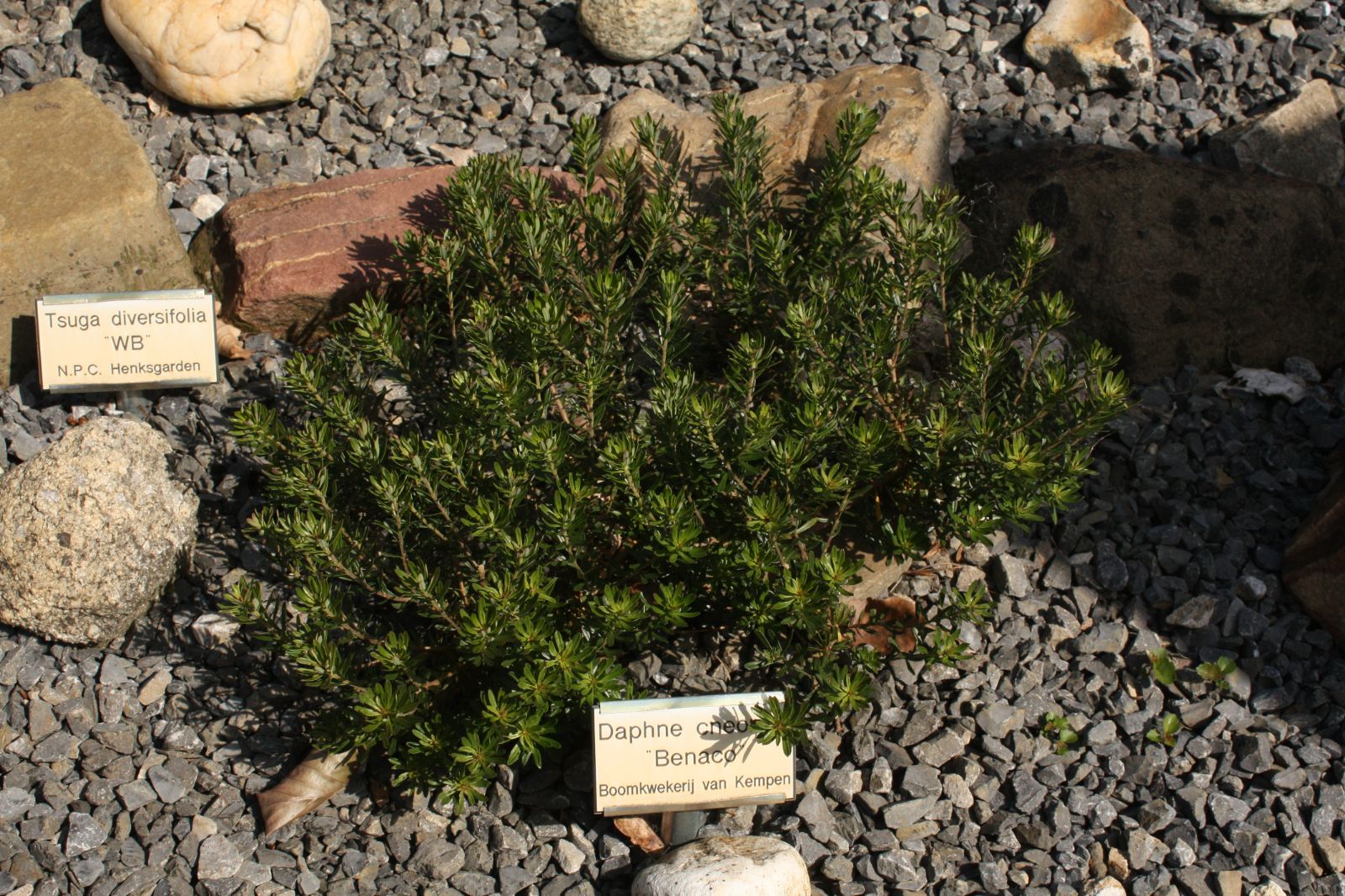Daphne cneorum
Credits
Article from Bean's Trees and Shrubs Hardy in the British Isles
Recommended citation
'Daphne cneorum' from the website Trees and Shrubs Online (treesandshrubsonline.
Genus
Common Names
- Garland Flower
Infraspecifics
Other taxa in genus
- Daphne acutiloba
- Daphne alpina
- Daphne altaica
- Daphne aurantiaca
- Daphne bholua
- Daphne blagayana
- Daphne × burkwoodii
- Daphne caucasica
- Daphne collina
- Daphne genkwa
- Daphne giraldii
- Daphne × houtteana
- Daphne × hybrida
- Daphne jezoensis
- Daphne laureola
- Daphne mezereum
- Daphne × napolitana
- Daphne × neapolitana
- Daphne odora
- Daphne oleoides
- Daphne petraea
- Daphne pontica
- Daphne pseudomezereum
- Daphne retusa
- Daphne rodriguezii
- Daphne × rossetii
- Daphne sophia
- Daphne striata
- Daphne tangutica
An evergreen trailing shrub, producing a great number of long, slender, minutely downy branches, densely clothed with leaves, and forming a low, spreading mass under 1 ft high. Leaves oblanceolate, with a tapering base and broadly wedge-shaped apex, ending in a minute bristle-like tip, 3⁄4 to 1 in. long, 1⁄8 to 1⁄5 in. wide, dark green above, greyish beneath, glabrous. Flowers crowded in a dense terminal cluster, numerous, scarcely stalked; they are fragrant and rich rosy pink, the tube 3⁄8 in. long, very downy outside, the expanded part 3⁄8 in. across, with ovate-oblong lobes. Blossoms in May. Bot. Mag., t. 313.
Native of Europe from Spain to S.W. Russia; cultivated 1752. It is the best and most useful of the evergreen species, from all the rest of which grown in gardens it is distinguished by its lax, prostrate habit. It flowers with remarkable freedom, the leaves being almost entirely hidden by bloom. It likes a permanently moist root-run, and apparently thrives well in calcareous soil. Some of the healthiest plants I have seen in the London district were (some years ago) in one of the plots under the control of the London County Council on Plumstead Common, Kent. This place is on a limestone formation, and is perhaps 200 ft above the Thames. The plants had, apparently, treatment similar to that meted out to privets and such-like, but were in rude health. At the same time it succeeds splendidly in the R.H.S. Garden at Wisley, where the soil is a sandy peat. It is a good plan to layer the outer shoots by placing stones on them, as recommended for D. blagayana.
From the Supplement (Vol. V)
The derivative of ‘cneorum’, here used by Linnaeus as a noun-epithet, is explained under the genus Cneorum in Volume I.
var. pygmaea – For a discussion of the dwarf forms of D. cneorum, see Brickell and Mathew, op. cit., pp. 89–90. A beautiful pink-flowered dwarf form received an Award of Merit when shown by Messrs Ingwersen in 1983.
It should be added that there is a gold-margined clone of D. cneorum in cultivation.
† D. velenovskyi Halda – Previously identified as D. cneorum, this daphne occurs on Mount Vichren in Bulgaria and was described by the Czechoslovak authority J. Halda in 1981 (Preslia, Vol. 53, pp. 345–7). See also: Qtly Bull. Alp. Gard. Soc., Vol. 50, pp. 268–70 (1982).
'Alba'
Flowers white. It received an Award of Merit when shown by Messrs Tucker in 1920. The plant now in commerce resembles the var. pygmaea in habit.D julia Kozo-Polianski
Although recognised as a species in the Flora of the Soviet Union, this daphne is very near to D. cneorum and indeed less distinct from the normal form of that species than is var. verlotii. Of the characters by which Kozo-Polianski distinguished his species from D. cneorum the most marked would seem to be the narrower leaves and the more congested inflorescences, with up to twenty-five flowers in each. This daphne is, however, of great interest to plant geographers, being a local endemic found in a restricted area from north-west to south-west of Voronezh (commonest near Barkalovka) and forming part of the remarkable flora referred to under D. sophia. Its habitat is on open slopes at a few hundred feet above sea-level, where it grows in limestone rubble or lime-rich black-earth (chernozem) in a steppe-like vegetation which contains, however, many species which, like the daphne, are alien to the steppe.D. julia was introduced to this country by Eliot Hodgkin, who received four plants from Moscow in 1960. One of these grew to be 3 ft across in the garden of the late E. B. Anderson.'Eximia'
Flowers larger than in the type, deep pink; it is also somewhat larger in leaf. The parent of this clone was one of a number of collected plants supplied to the late A. T. Johnson by Stormonth’s nursery, Carlisle. It was given an Award of Merit in 1938 and a First Class Certificate in 1967. What was apparently a similar form (at least in size of flower and leaf) was described by Dippel in the last century as var. major.f. arbusculoides Tuzson
Habit rather erect and leaf-margins revolute. This variant has been recorded from W. Hungary, S.E. Austria and N. Yugoslavia and is said to be confined to acid soils. For this information we are indebted to the revision of Daphne in Flora Europaea, Vol. 2 (1968), p. 258, where it is suggested that this variant may perhaps deserve recognition as a subspecies.var. pygmaea Stoker
Smaller in all its parts than the type; perianth tube irregularly wrinkled on the outside. Described by the late Fred Stoker from plants found and collected by him in the Venetian Alps at 8,000 ft (The New Flora and Sylva, Vol. 7, p. 275). Dwarf forms of D. cneorum found in the calcareous pre-Alps of S.E. France are discussed by Ruffier-Lanche in the article referred to below under var. verlotii (for an important correction to the text of this article see op. cit., Vol. 27, p. 156). A dwarf form of diffuse habit, with deep pink flowers, was introduced from the Pyrenees.var. verlotii (Gren. & Godr.) Meissn.
Synonyms
D. verlotii Gren. & Godr

